If your golf destination bucket list doesn’t include Branson, Missouri, you’re doing it wrong. Branson, dubbed the “Live Entertainment Capital of the World,” has long been known as a family-friendly entertainment destination. But with 10 world-class golf courses designed by the likes of Tiger Woods, Jack Nicklaus, Tom Fazio, Gary Player, and Ben Crenshaw all within 20 minutes of each other, Branson may want to consider calling itself the “Buddy Trip Capital of the World.”
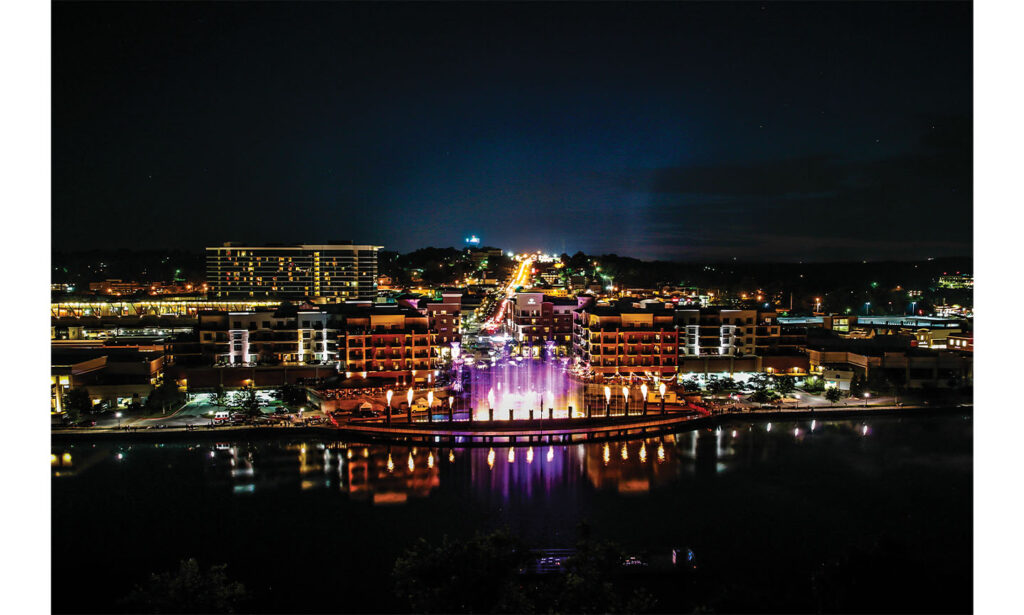
In a state that shares a border with eight others, the city of Branson sits on the southwest corner of the state, snuggling the Arkansas state line and smack dab in the middle of the Ozarks. This makes Branson politely Midwestern but just close enough to the South to draw some of the regional charm. It’s no surprise that Branson has always been at the forefront of popularizing the area’s Ozark culture.
The city welcomes over 10 million visitors a year, ranking it 20th among all leisure destinations in the U.S. It boasts over 40 music theaters with a capacity over 50,000 seats playing everything from country, bluegrass, and gospel to pop, rock n’ roll, and Broadway.
Outside of the entertainment district, Branson Landing offers waterfront dining, shopping, and lodging overlooking Lake Taneycomo just steps from Branson’s Historic District. You can visit the Bass Pro Shops at Branson Landing and dine at White River Fish House, a floating eatery that was recently voted the “Best Overall Restaurant” in Branson. Other worthwhile dining options include Guy Fieri’s Kitchen & Bar, Paula Deen’s Family Kitchen, Rocky Mountain Chocolate Factory, and local favorite Waxy O’Shea’s Irish Pub, which serves up a mean Irish Car Bomb and features live music on the weekends. The outdoor terrace at Waxy O’Shea’s welcomes cigar smokers, although you shouldn’t expect cigar ashtrays or table service outside. Their selection of top-shelf Irish whiskies and a perfectly poured pint of Guinness will help ease your pain.
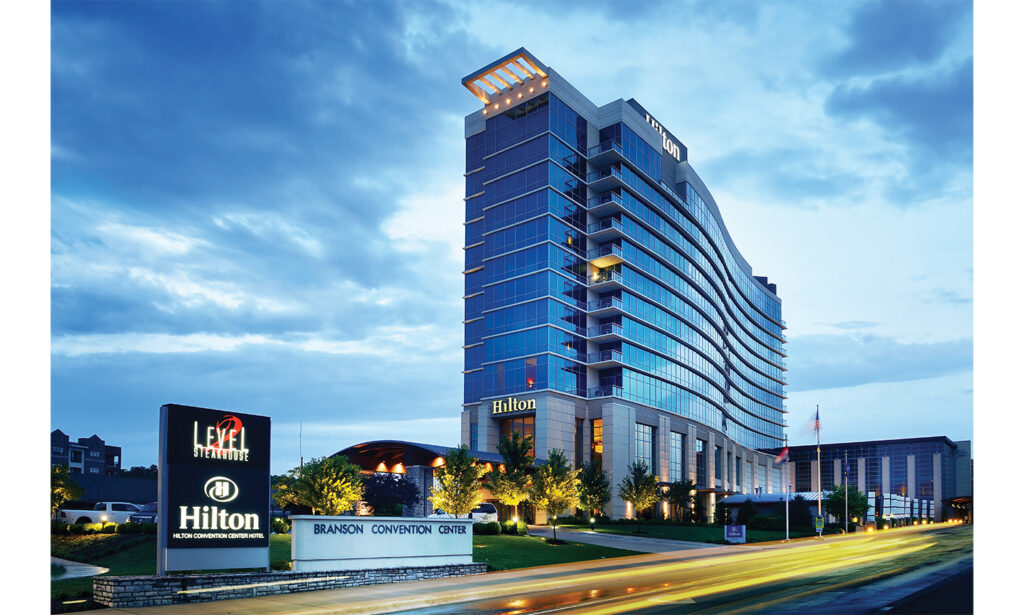
For lodging, Branson Landing offers up two Hilton properties. Hilton Promenade at Branson Landing and Hilton Branson Convention Center. The latter is home to one of the area’s top restaurants, Level 2 Steakhouse. This classic steakhouse serves up 28-day aged corn-fed Midwest sourced beef seared in their 1,600-degree infrared oven. All carnivores can select from five distinct steak knives but frequent visitors can join the Kut Klub and use their own engraved blade during their visit.
Visitors to Branson’s Historic District should not miss Dick’s 5 & 10, which recently celebrated its 60th anniversary. It’s a classic, family owned 5 & 10 that takes you back to your childhood with unique gifts, souvenirs, candies, hobby supplies, and too much variety to fit into this story. The store is owned and operated by the original family although founder Dick Hartley passed away in 2006. His son Steve Hartley can be seen helping customers, ringing registers, and stocking shelves seven days a week.
AN OUTDOOR PARADISE
The Ozark’s lakes and waterways draw anglers from all over the world to fish for bass and trout. Some of the largest bass caught in the state of Missouri have been hooked in Table Rock Lake, while Lake Taneycomo is the spot for trout.
It was fishing on those lakes that enthralled a young Johnny Morris. He also saw a need for a dedicated tackle shop, so in 1972, he opened one in a small space in the back of his father’s liquor store, Brown Derby Liquors, in nearby Springfield. It was a small space, eight square feet, and he called it Bass Pro Shops.
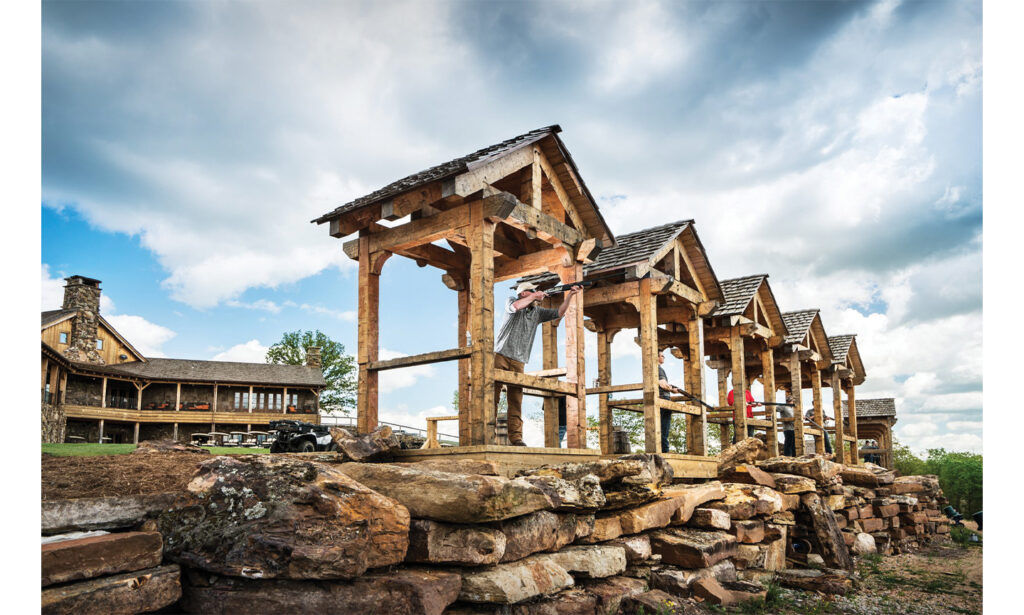
From early on he leveraged the power of multi-channel sales by sending out a Bass Pro Catalog to anglers anywhere in the country. Bass Pro Shops operated out of that space in the liquor store for the first 13 years and eventually grew into the outdoor sporting goods giant that it is today.
Bass Pro Shops operates 200 stores nationwide including a mammoth 500,000-square-foot outpost in Springfield. The store also serves as the company headquarters where Morris still oversees day-to-day operations. The company also owns the White River Marine Group, which manufactures and distributes the Tracker, Ranger, Tahoe, and Mako boat brands, to name a few.
Building on the success of Bass Pro Shops, Johnny Morris purchased a 4,600-acre property overlooking Table Rock Lake in 1987. The property had previously been a wilderness retreat owned by two Missouri natives, Jude Simmons and Harry Worman, in the 1920s, and was turned into a guest ranch in 1947 by Dan Norris. Upon completion of the purchase, Johnny Morris quickly set out to restore the Simmons and Worman buildings and began a quest to develop the property into the premier wilderness resort in the Ozarks, Big Cedar Lodge.
Big Cedar aims to connect families and friends to nature with a steady eye towards conservation and respect for the great outdoors. The resort offers lodging of all varieties, from exclusive villas and cottages including the one-of-a-kind Jack’s Cabin located at Top of the Rock overlooking the 9th hole of the short course designed by Jack Nicklaus and the two Angler’s Lodge hotels located off property.
Regardless of your outdoor pursuits, Big Cedar has you covered, with boat rentals for fishing, tubing, water skiing, or just spending the day on the water. There’s a shooting academy designed for all levels and for all types of shooting sports including trap, skeet, clays, and 5-stand. There’s also Fun Mountain where kids (of any age) can race go-karts, try their hand at a ropes course, shoot each other with lasers, and wind down with bowling and billiards.
Dining at Big Cedar is headlined by the upscale Osage Restaurant at Top of the Rock. Arrive while it’s still daylight to enjoy the sweeping views of the Ozark Mountains and Table Rock Lake, but above all don’t miss the daily Sunset Ceremony. As the sun starts to dip into the horizon, a Civil War-era cannon is fired as guests raise their glass for a toast.
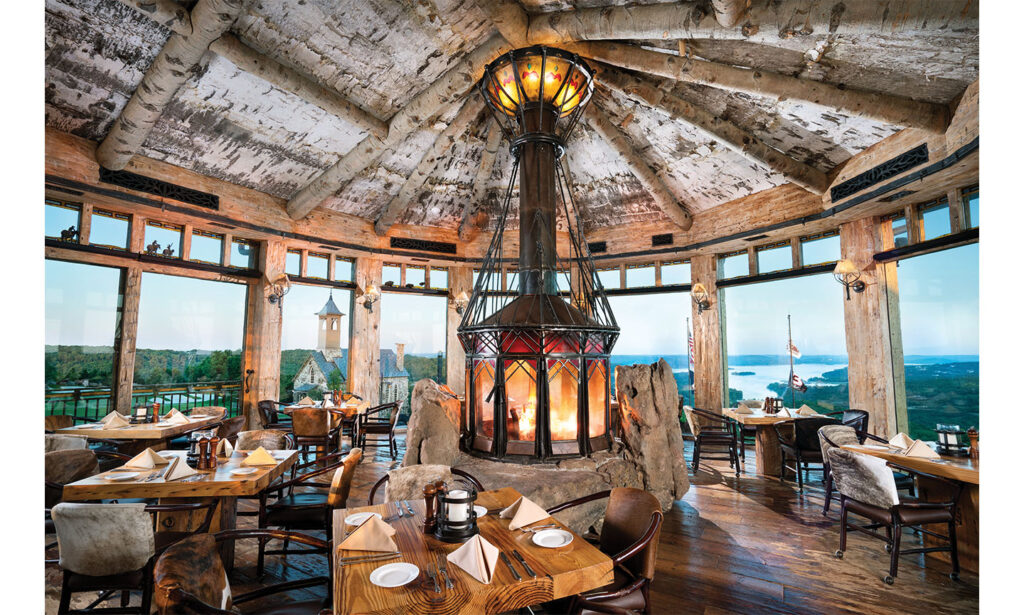
If you’re up for a pre- or post-dinner cocktail and smoke, make your way down to the End of the Trail All-American Wine Cellar, which sits underneath Osage Restaurant. Walking past room after room of wine collections as you make your way down the stonewalled corridors of the cellar feels like you’ve been transported into a clean and well-appointed version of an old world cellar until you come upon a wall of bourbon behind a semi-circle bar. The selection of hard-to-find American whiskies was impressive; ask for a neat pour of High West Midwinter Night’s Dram and grab a smoke from the well-stocked walk-in humidor. Better yet, ask Krupp (the bartender) for a recommendation and watch him perk up at the chance to drop some bourbon knowledge on you.
A conveniently placed patio and lawn area just past the wine cellar’s bar provides the perfect place to enjoy a cigar overlooking the Chapel of the Ozarks, #1 on Top of the Rock Golf Course, and Table Rock Lake further in the distance. Servers will provide you with a proper ashtray as well as a cut and light if needed. It could just be the best spot on the property to savor your favorite blend.
GOLF HEAVEN
Stir-crazy golfers kept away from their weekend pastime during the pandemic tuned in en masse on Tuesday, September 22nd, 2020, to watch the Payne’s Valley Cup on the Golf Channel. The broadcast unveiled Big Cedar Lodge’s newest course, the Tiger Woods-designed Payne’s Valley, for a 2 v 2 exhibition match between Tiger Woods/Justin Thomas and Rory McIlroy/Justin Rose. The made-for-television match not only paid tribute to the late Missouri native and World Golf Hall of Famer, Payne Stewart, but also raised money for the Payne Stewart Family Foundation. After the Woods/Thomas team secured the victory, the players were joined by legends Jack Nicklaus and Gary Player for a closest-to-the-pin competition on the breathtaking 19th hole.
Unlike the rest of the course, this bonus hole, affectionately called The Big Rock. was designed by Johnny Morris himself and mesmerizes golfers with a 134-yard shot to an island green surrounded by a giant limestone rock face with a waterfall feeding the water hazard that separates the player from the safety of the green. There’s a strategically placed bar just to the left of the walkway up to the elevated tee, which serves up the liquid courage needed to tackle The Big Rock.
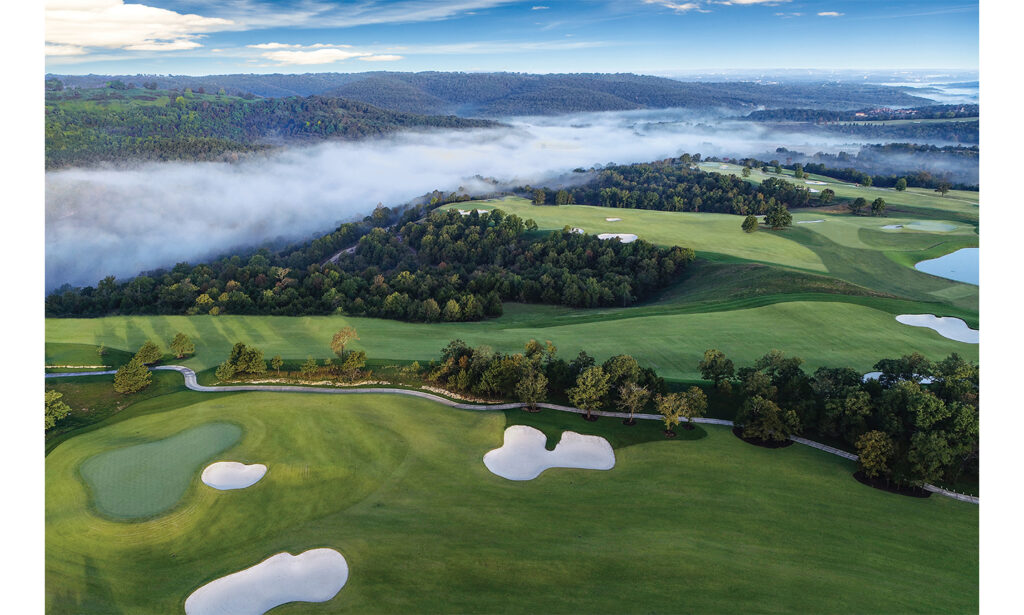
Coverage of the Payne’s Valley Cup was an overwhelming success for the Golf Channel. It was the most watched Tuesday telecast since the network’s 2018 Masters coverage, which featured the long-anticipated Tiger Woods and Phil Mickelson practice round at Augusta National. But the impact of that unveiling was far more tangible at Big Cedar. Bob Newell, VP of Golf for Big Cedar, told Cigar Snob, “We had nearly 80,000 calls and emails for tee times in the days that followed the event airing on national TV and total rounds grew nearly 50%.”
Tiger Woods’ association with the course and more than a little serendipity helped push Payne’s Valley into the consciousness and bucket lists of golfers everywhere.
“It’s a huge impact to have Tiger associated with a course at Big Cedar,” Newell said, “especially since the year it opened Tiger also surged back professionally to win the 2020 Masters. It’s a very timely coincidence for us but even if Tiger wasn’t attached, that course has great golf characteristics with open playing space, really fun green complexes plus the natural beauty of the Ozarks as its backdrop.”
Big Cedar Golf was born of Johnny Morris’s desire to connect people to nature, be it by fishing, hunting, hiking, or blasting drives onto pristine fairways surrounded by the grandeur of nature. Big Cedar’s golf offerings are all public and include three 18-hole courses and two short courses designed by some of the biggest names in the game.
Payne’s Valley
The most recognizable of the courses was the first public course designed by Tiger Woods and his TGR design firm. Golf Digest named it the “Best New Public Course in America” in 2021 and it’s no surprise. With six different tee positions, the par 72 layout elegantly offers a challenge for players of all levels. The Tiger Tees, designed for tour level players, comes in at a stout 7,370 yards, while blue tees are 6,876, white tees are 6,133, and red tees are 4,957. One interesting tee option is the combo tees, which combine the blue and white for mid to low handicaps and red and white for high to mid handicaps.
The course is extremely driver friendly. “The water features along the course are all really unique but from a golf playability standpoint, the hallmark features would have to be the open fairways,” Newell said. “It’s a great course to pound driver on nearly every hole.”
Tiger’s design features several risk-reward par-5s including the picturesque #4, at 484 from the whites. A solid tee shot down the right side offers a chance to get home in two but the smallish green is protected by a creek if you come up short, a lake if you’re left, and a bunker if you’re long. The exposed limestone along the right side offers a beautiful backdrop to this early test.
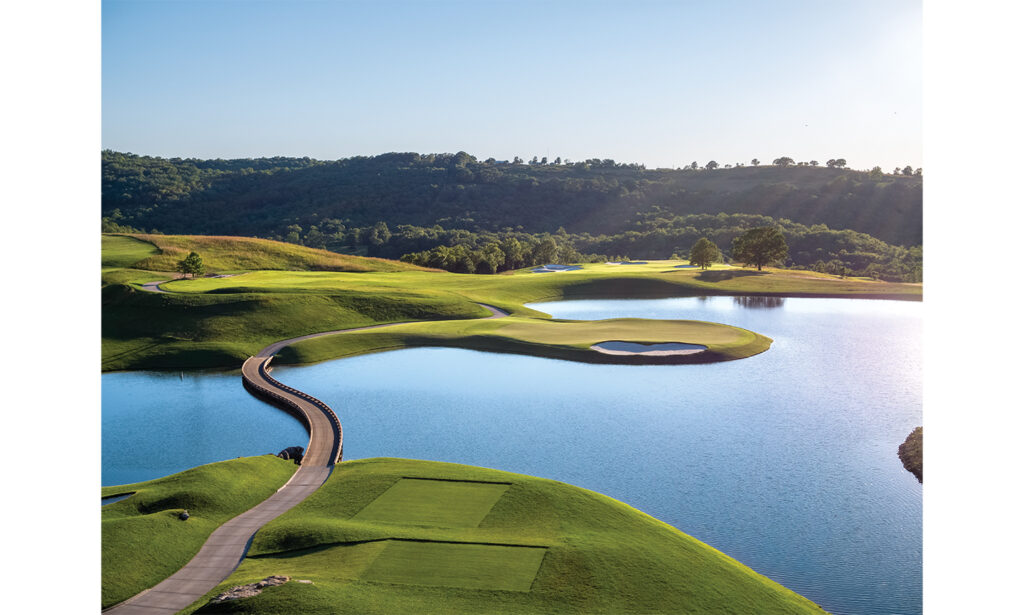
Things don’t necessarily get easier as you’ll want to come into #5 with confidence. This peninsula green sitting peacefully at 179 yards for those playing from the blues requires a well-measured iron shot. Your reward is a scenic ride along the bridge before facing the sloped, fast green.
All of the Big Cedar golf courses offer snacks, beverages, ice cream, and local bison dogs included with your green fees but the turn at Payne’s Valley allows you to enjoy your bison dog while watching the group ahead of you take aim at the difficult-to-gauge downhill par-3 with trouble all around. It plays 161 from the blues and 140 from the whites; there should be a neon sign at the tee box flashing DON’T BE LEFT and DON’T BE SHORT. If you’re not feeling particularly comfortable over this one, there’s a safe bailout to the right with a mound that caresses your errant shot back towards the putting surface, a welcome relief for those with a big right-miss.
Riding up to the famous 19th hole after your round, your cart narrates some of the facts and history of the hole. As you come around the wall of limestone, it’s hard not to feel a childlike excitement as your view opens and the magnificence of the 19th comes into view. Your first glimpse of the 200 ft. cliff with water rushing through it is quite possibly the main reason that you played the course to begin with.
Newell puts into words what everyone that plays Payne’s Valley is thinking: “#19 is definitely the biggest attraction on the course. You start to see it from hole #14 and it builds up as you get closer and see more of it. It’s easily the most talked about aspect of the course.”
The Big Rock is also the place where final bets are settled or new ones are made for the final test of your iron play. The green is generous in depth but veering off to either side will undoubtedly leave you buying the next round of drinks.
The ride from #19 up to the clubhouse is an adventure ride through the limestone, behind waterfalls, and over shallow creeks that add that final touch of detail that makes this place that much more interesting. It’s a fitting tip of the cap to this majestic place as you zigzag up the cliff with grand views of the course below and the beauty of the Ozarks all around.
Ozarks National
While Payne’s Valley gets the lion’s share of the hype, Ozarks National is perhaps the most suitable of the Big Cedar courses for a PGA Tour stop, at least from a difficulty standpoint. To our eye, the Coore & Crenshaw design was the most challenging of the Big Cedar courses, although Newell offered some words of wisdom about the course he plays most often. “It’s considered the most challenging, but the more you play it the more you realize it’s very score-able,” he said. “You just have to learn the breaks and how the ball reacts on the rolling fairways. Once you figure out where you can play aggressive and where you need to play defensive, it makes the strategy involved in playing that course so much fun.”
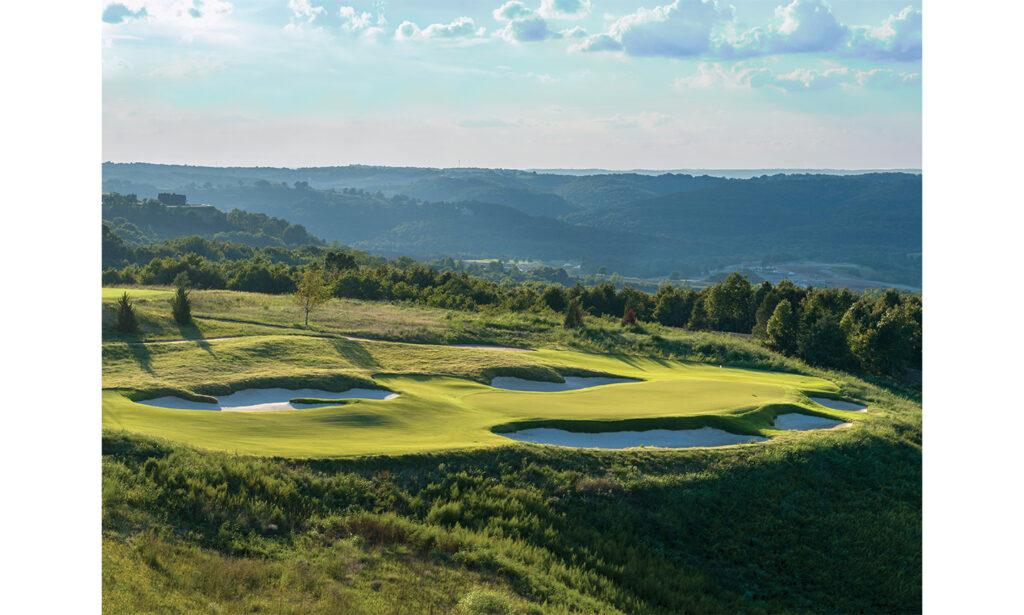
Most of us, however, won’t have the luxury to play the course enough to have that level of familiarity and for that, Newell suggests you take a forecaddie. The blind shots and occasional narrow fairways certainly necessitate it. “If you’re hitting your driver well or playing conservatively off the tee you can post a great number there and our forecaddies can help a lot with that.”
The course opened in 2019 to numerous accolades. Golf Digest named it the “Best New Public Course in America” in 2019 and Golfweek called it the “Best Course You Can Play in Missouri” in 2020. The holes are routed along a mountain ridge with dramatic, seemingly endless views and maximum, unprotected wind exposure. The wind variable along with the C&C design gives the course a links-like feel that sets it apart from the other Big Cedar 18-hole courses. There are six tee positions to choose from including two combos, like Payne’s Valley. The back tees, called Ozarks, play at 7,036 yards, the blues at 6,510, white tees at 5,903, and reds at 5,025.
The course’s location atop the ridge is probably best accentuated by the short par-4 #5, which takes you down and uphill while snaking right, then left up to an elevated green. Overlooking the green complex is a 100-year-old stone house that is often used as an aim point, a restored remnant of the property’s previous life as a dairy farm.
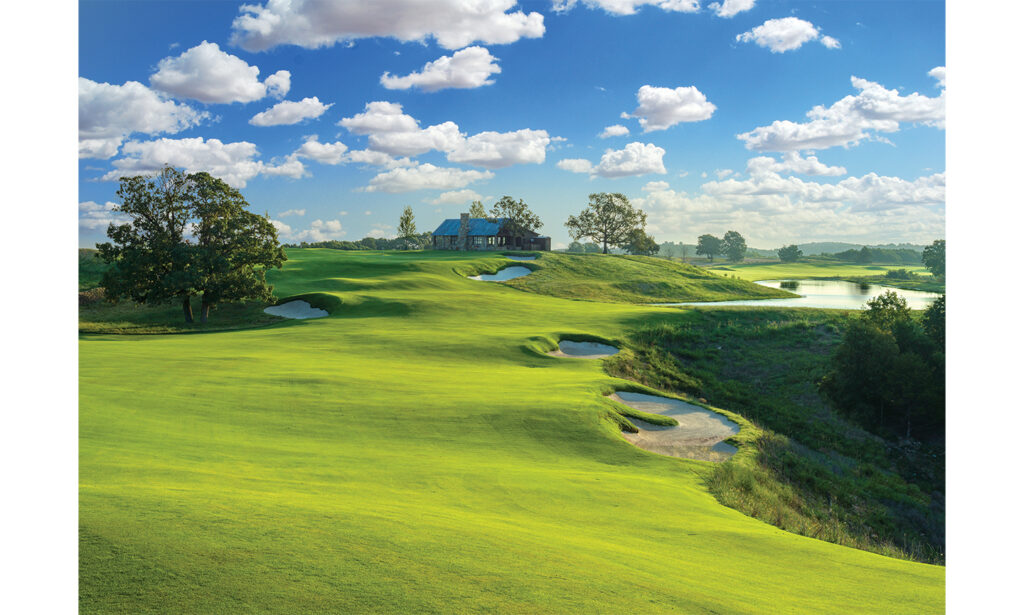
The stone house behind the #5 green is not the only clever use of landmarks throughout the layout. A lone pine on the par-5 #11 marks the center of the fairway for your tee shot, while a second one further up the fairway alerts you of impending doom to the left. The way Coore and Crenshaw used the ridges, landmarks, and native vegetation make Ozarks National feel like an old, established course when in fact it’s quite new.
Buffalo Ridge
Everything about Buffalo Ridge is more laid back, from the sign at the entrance welcoming “Fishermen, Golfers, and Other Liars,” to the herd of bison grazing on native grass on your left off the #1 tee. While situated on the same parcel of land that houses Payne’s Valley, Ozarks National, and Mountain Top Course, Buffalo Ridge feels much more remote.
There’s an excellent practice facility out front as well as a terrace with tables where you can enjoy a post-round smoke.
The layout was designed by Tom Fazio and although it is often overlooked because of the newer, sexier courses, it is a gem of a track. Bob Newell echoed those sentiments and compared it to the others. “Usually after people play it, they are surprised at how good of a course it is,” Newell said. “Ozarks National is a first shot course and will challenge your driver. Payne’s Valley has great green complexes that will challenge your short game and putting. Buffalo Ridge is a second shot course, the fairways are wide, but the approach shots are difficult, and missing the greens in the wrong spot can leave you with a real challenging up-and-down for par. It’s the perfect complement to the other courses.”
Yardages are broken out into six positions with the back tees, called Buffalo tees on this course, at 7,036 yards. That’s not a typo; it’s strangely the exact same length from the back as Ozarks National. Blue tees are set up at 6,616 yards, whites at 5,881, and reds at 5,004. Like its sister courses, Buffalo Ridge also offers combo tees for those “in-between” players.
At several points during your round, you will see herds of American bison grazing and it takes a moment to let that settle in. They say there’s a rare albino bison in the herd, but they could just be trying to get newbies off their game. Don’t be distracted, the course demands respect.
Fazio throws you right into the fire on #2 with a difficult test of your nerve. This par-4 playing at 458 yards from the blues tees has a giant limestone protrusion jutting into the fairway from the left urging you to be right, but that makes your second shot that much longer into a protected bunker. It’s one example of how the course uses the natural contours of this area to its advantage.
The short but adventurous par-4 #15 could be the most dramatic hole on the property. It plays from just 348 from the blues and 309 from the whites and opens with a downhill tee shot into an uphill sloping fairway. Oh, and there are a series of waterfalls all along the right side of the fairway and treacherous bunkers along the left. Even after you navigate that gauntlet, your second shot is into a green with a false front, bunkers to the right, and a limestone ledge that seems to be begging you to use it as a backstop. Don’t do it.
Mountain Top
With Mountain Top Course’s first tee located just off to the side of the Payne’s Valley clubhouse, it’s easy to want to fire up a smoke, grab a pull cart, and set off on the 13-hole short course. The par-3 track was designed by Gary Player and it provides a fun golf experience for the entire family. The holes are short enough for kids to play, especially from the forward tees, which play at 1,091 yards. The back tees provide more of a challenge for players at 1,912 yards but the whole experience has a much more laid back, fun feel than a proper 18-hole course.
Most par-3 courses require that you grab just a couple of clubs and a putter but that’s not the case at Mountain Top. Depending on the wind, you’ll find yourself going through most of your bag if you play from the back tees. After a short 82-yard opening hole, the 221-yard #2 is perhaps the toughest hole on the course. It plays uphill the whole way and features a false front that could have your ball rolling back towards you if you’re short.
Top of the Rock
Unlike Big Cedar’s Mountain Top short course, which requires inventive shot-making and most of the clubs in your bag, Top of the Rock is more of a classic 9-hole, par-3. Classic? Yes. Typical? Not by a long shot. The Jack Nicklaus Signature design became the only par-3 course ever to be part of a PGA event when it hosted the Champions Tour – Legends of Golf from 2014 to 2019. Tim Finchem, the former commissioner of the PGA Tour, famously stated at the time, “If there was ever a par-3 course worthy of PGA Tour tournament play, Top of the Rock is it.”
Top of the Rock looks and plays like a golf course of your dreams. There’s no wasted motion, with jaw-dropping views at every turn and holes that remind you of some of golf’s most iconic holes. It features three tee positions with the black tees playing from 1,420 yards, the bronze tees at 1,284, and the reds at 945. Hole #2 is one of those “Am I dreaming?” holes, short and severely downhill, and at 114 yards from the black it feels like you’re inevitably going to hit it into Table Rock Lake in the background.
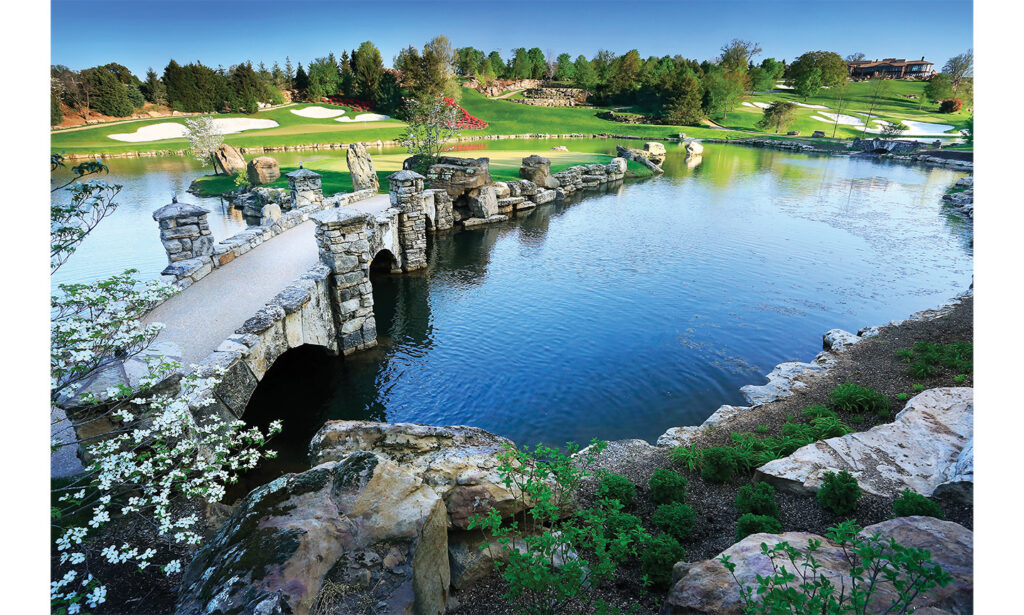
Standing at the tee at #4, you could swear you’re at #12 at Augusta National, except it’s quite a bit longer at 191 yards from the black tees. Just about every green at Top of the Rock is menacingly protected by bunkers but the 121-yard island green #6 is where precision is most needed. From the tee, even the bridge onto the green is cleverly obscured from view giving you more questions over the ball than you can possibly answer.
After the round, check out Arnie’s Barn, a 150-year-old barn from Arnold Palmer’s Latrobe, PA, backyard that was meticulously relocated to Top of the Rock. The barn serves as the pro shop and restaurant serving Texas BBQ and Tex-Mex cuisine.
Branson Golf
Big Cedar Golf and more specifically Payne’s Valley is the reason that most destination golfers worth their salt have Branson on their bucket lists, but there’s no drop-off in quality golf outside of Big Cedar. A 20-minute drive from Payne’s Valley you’ll find Branson Hills Golf Course, a top-notch track designed by Chuck Smith with the consultation of the famed Bobby Clampett. The course has received its fair share of accolades with Golf Channel’s Golf Advisor calling it the #1 “Course to Play in Missouri,” the 36th “Best Course in America,” and the 49th “Toughest Course in America” in 2021. Golfweek had it as the #1 “Course in Missouri” from 2012 to 2018.
This public gem offers a dizzying amount of elevation change and a mature forest surrounds the track. The course offers six tee options with the gold tees topping out at 7,324 yards, green tees at 7,046, blues at 6,741, silver tees at 6,299, and orange tees at 5,323. There is one combo tee option that combines the silver and orange tees.
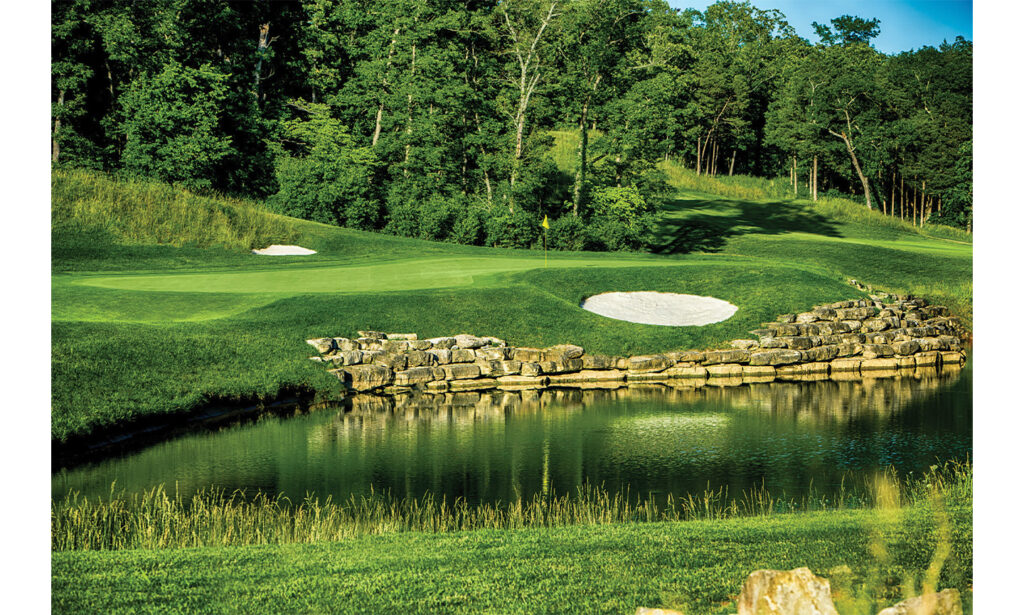
The first hole is an apt introduction to the elevation change and difficulty of the layout, with a force-carry over dense rough and a 130-foot drop from tee to green. Greens are slick and some pin placements can be downright diabolical but are always a fun test. After a difficult, long par-3 #2, the short and downhill par-4 offers the first real chance to gain some ground but it comes at a risk. The green is reachable thanks to the downhill slope but the fairway narrows significantly leaving a dense forest and a bunker in play off the tee. But you didn’t come all the way out here to shy away from hitting driver at the first sign of trouble. Hit it.
The most difficult and daunting hole at Branson Hills is #18. Standing at the tee you face what looks like a wall of fairway as this severely uphill par-4 plays from 427 yards from the gold, 415 yards from the blues, and 246 from the reds. The blind, uphill tee shot requires some knowledge of where to aim. While we hear that cart GPSs are in the works, they are not currently available, so bring your own GPS or play the course twice. It’s worth it.
The clubhouse is large and beautifully appointed and the Magnolia Grille prepares excellent sandwiches, chicken wings, and pizzas. You can also pick up cigars at the restaurant; they can be enjoyed on the terrace outside overlooking #18. After getting your teeth kicked in by #18, it can help the ego to watch others struggle with it as you enjoy a fine smoke.
Embers Cigar Lounge
Every golf course we came across in Branson had cigars for sale and most of the time the golf course humidors were stocked by the fine folks from Embers Cigar Lounge. The real deal, however, is just across the river from Branson Landing, in the picturesque town of Hollister.
Embers owners Kevin and Betsy McConnell have created the ideal cigar lounge out of what feels like an old place of worship. At the right time of day the light comes in through the high windows above the main entrance giving the place an idyllic vibe. Step inside the walk-in humidor and you’ll find yourself worshiping at the altar to Fuente Fuente Opus X thanks to an impressive, custom-made island shelf with hanging tobacco. In addition to Fuente, the selection is varied with big names like Drew Estate, Padrón, Camacho, and Cohiba as well as smaller, lesser-known boutiques. Once you’ve selected your smoke, the lounge offers beer from local breweries and wine by the glass or bottle.
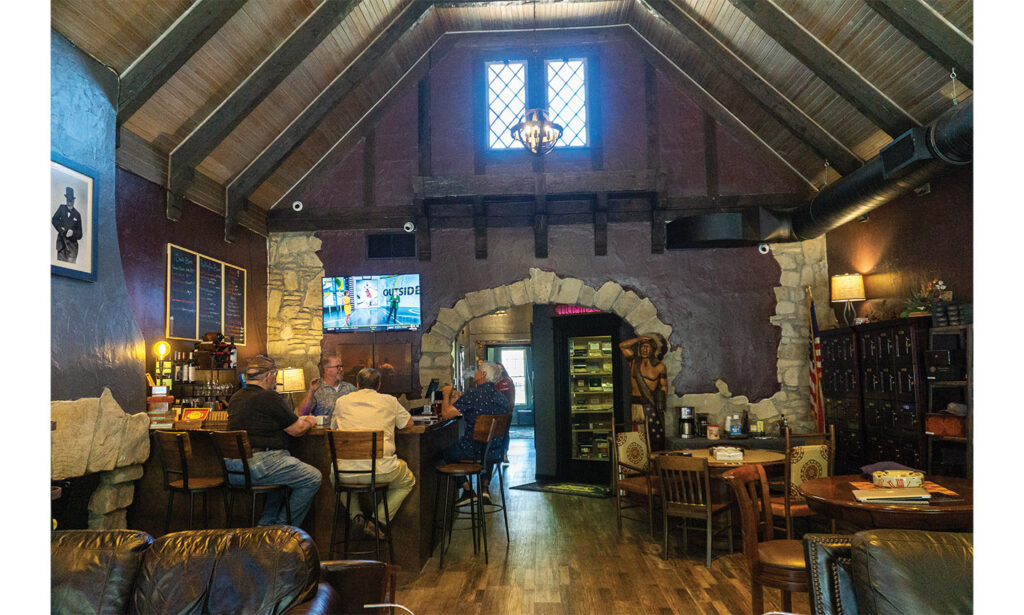
Locals tell us that after you’ve worked up an appetite at Ember’s, the move is to go a couple doors down to Downing Street Pour House and order the championship wings, a wagyu burger, and kettle chips. We hear that’ll add 20 yards off the tee for you.
Before watching the Payne’s Valley Cup, Branson had not been on my radar. But after spending a week playing the incredible golf courses surrounded by the singular natural beauty of the Ozarks, I’m itching to go back even if just to exact my revenge on the 19th at Payne’s Valley.
With 10 public, top-notch courses within 20 minutes of one another, Branson wins plenty of arguments when compared to other golf-centric buddy’s trip destinations. Factor in its proximity to a large portion of the country, the world-class fishing and outdoor activities, and the family friendly nature of the area’s attractions, and it starts to tip the scales as one of the best all-around vacation spots.




